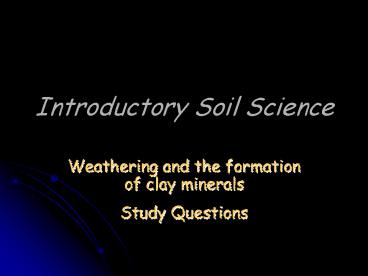Introductory Soil Science - PowerPoint PPT Presentation
1 / 9
Title:
Introductory Soil Science
Description:
... weathering products that produce clastic sediment and the mineral component of soil. ... Quartz is a primary mineral that resists chemical weathering so is ... – PowerPoint PPT presentation
Number of Views:102
Avg rating:3.0/5.0
Title: Introductory Soil Science
1
Introductory Soil Science
- Weathering and the formation of clay minerals
- Study Questions
2
Weathering
- Where does weathering occur?
- At or near the surface of Earth
- Requires interaction between the lithosophere ,
atmosphere and hydrosphere and perhaps biosphere - Powered by solar energy
- What is regolith?
- It is the weathered outer part of the crust
3
Weathering
- What are the two main mineral weathering products
that produce clastic sediment and the mineral
component of soil. - Quartz and clay
- Quartz is a primary mineral that resists chemical
weathering so is only affected by mechanical
processes - Clay is a secondary mineral that is formed by the
processes of chemical weathering - recombination of the alumina and silica sheets
that result from the hydrolysis, carbonation and
oxidation of primary silicates form
anions(micelles) that attract the free cations to
form clays
4
Weathering
- What is the difference between chemical and
mechanical/physical weathering? - Chemical weathering leads to the formation of new
minerals and soluble products - Mechanical simply breaks the rock into smaller
particles with no change in chemical composition
5
Clays
- Briefly describe the 3 different meanings of the
term clay in soil usage. - Mineral family name
- Particle size designation
- Textural term
6
Clays
- How do clay minerals form?
- By chemical weathering processes
- Original silicate minerals are chemically broken
into octahedral alumina tetrahedral silicate
sheets that recombine to form the micelles - Micelles are negatively charged (anions)
- Attract cations to form clay minerals
7
Clays
- Describe the difference between the octahedral
structure of the alumina layer and the
tetrahedral structure of the silica layer in the
clay micelle. - In the octahedral layer the aluminium atom is
surrounded by 6 oxygen atoms - In the tetrahedral layer the silicon atom is
surrounded by 4 oxygen atoms
8
Clays
- What is the difference in the structure of 11
and 21 clays? - 11 clays have 1 alumina and 1 silica layer
- 21 clays have 1 alumina and 2 silica layers
9
Clays
- How does this difference explain differences in
the shrink/swell properties of clays? - Sheets in 11 clays are strongly held together
and do not allow water in - Sheets in 21 clays are not as strongly held
together and allow water in - What is cation exchange?
- The exchange of cations between clay minerals and
the surrounding environments, eg. plant roots































